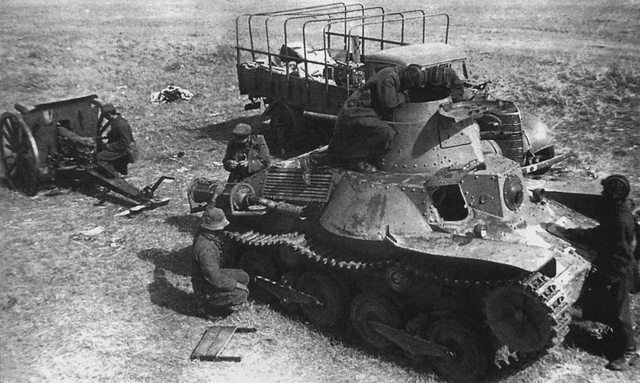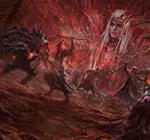明斯克卫星计划:日系TD计划浮出水面
17173 新闻导语
明斯克卫星计划:日系TD计划浮出水面
This is Part 1 of the Japanese **** Destroyer Series, dealing with the origins of **** destroyer development and the first results. Before we look into the beginnings of the pretty meager collection of Japanese **** destroyers, we need to first understand how **** destroyers came about.
The first **** destroyers were basically stopgap solutions, mounting an anti-**** gun on a tracked vehicle and calling it a dedicated anti-**** weapon. The German Panzerjägers, anti-**** guns in an open-topped superstructure on a light **** chassis, were the major starting point for this idea. The existence of heavy French ****s like the Char B1, which were beyond the capabilities of the major anti-**** guns in service, meant that the Germans needed larger guns on mobile platforms. That is how Panzerjäger I and the Marder series came about: putting larger anti-**** guns on **** chassis to give them the mobility to keep up with the rest of the armored forces. It was only as the war went on that with more powerful ****s coming to the battlefield that we have the appearances of casemates on medium/heavy **** chassis armed with powerful guns.
Now, considering this background, one has to put onself into the mindset of the Imperial Japanese Army to understand why Japan was never too keen on developing **** destroyers. When your current enemy barely has any armor to speak off, and you have a non-aggression treaty with potential enemy to the north (which you fought before, and realized that your current towed anti-**** guns were adequate for the job), why would you go through the trouble of trying to stick larger guns on your already limited **** chassis? After all, your 37 mm Anti-**** Gun Type 94 could just about deal with anything in your path, including those Western powers in Southeast Asia with their Universal Carriers, Lanchester Armoured Cars, Carden Loyd ****ette, and Stuarts. Your industrial capacity is already strained to the breaking point with a massive continental war. So, why bother with this **** destroyer nonsense?
Obviously, when yo***ealize that perhaps one or two of those enemies might be bringing something more protected.
这是本子TD线第一部分,处理了TD的起源和(得出)第一个结论。在我们深入研究这些相当稀少的TD搜集资料之前,我们要搞清楚TD怎样产生的。第一个TD基本上就是个应急措施,在履带车上安装了反坦克炮,并把它叫做反坦克武器。
第一个TD基本上就是个应急措施,在履带车上安装了反坦克炮,并把它叫做专用反坦克武器。德国猎人坦克(一突?后文有提到1突,我百度了一下,第一个坦歼的车体是1号坦克,jägers德语是猎人,追猎者就是Pirschjäger),反坦克炮安装在轻坦壳体的上面敞篷部分,这是这个想法的初次尝试。因为法国人拥有一些重型坦克比如B1,超越了当时在役的主流反坦克炮的能力,这意味着德国人需要在移动平台安装更大(口径)的火炮。这就是1突和黄鼠狼系列怎么出现的:将更大的反坦克炮安装在坦克底盘上,使其具有机动性,跟上装甲部队的其余部分。随着战争进程,只有当更牛逼的坦克出现在战场上时,我们才能看到基于中型/重型坦克的TD出现。考虑到这一背景,站在帝国陆军的立场上,你就会知道为啥日本不热衷于坦歼了。如果你眼前的敌人几乎没有任何的装甲可讲,而且,在北方你还有一个签过了互不侵犯条约的潜在敌人(通过之前的交火,你发现现有的拖曳式反坦克炮足够对付他们了),你为啥还要挑战在有限的车体上安装更大的炮的难题呢?毕竟,你的37毫米反坦克炮***可以解决你道路上所有的事情,也包括英美鬼畜部署在东南亚的通用载具、兰彻斯特装甲车、卡登洛伊德小坦克和斯图亚特。因为深陷**战争,你的工业能力已经捉襟见肘到濒临崩溃。所以,你为啥还在坦歼的废话上烦恼呢?
很显然,当你意识到也许一两个敌人也可能会带来更多的东西防御。

Contrary to what many think today, Japan did learn quite a few lessons in the clashes with the Soviet Union. These were consolidated into Nomonhan Research Report, a classified candid document not meant for public consumption, but intended for the use of staff officers who would be charged with implementing the recommendations. Of course, most of the suggestions were ultimately not implemented as it should have been, due to the core lack of industrial capacity Japan was facing during its entire time as an empire. Regardle***y, the document did have great influence over Japanese armor development, and would be the background for the making of the Japanese **** destroyer force.
和很多人现在认为的相反,日本确实在与苏联的冲突得到了到不少教训。这些被合并为诺门罕研究报告,一份****坦诚不对大众舆论开放,但给负责执行建议的参谋人员使用。当然,大部分的建议,并没有按期望值实现,由于在他整个作为帝国的时间内,日本面临的核心工业能力的缺乏。无论如何,该文件确实对日本装甲的发展有很大影响,并且成了为日本坦歼生产的背景。
关于的新闻
- (2025-11-27) 谁没收了它的175毫米主炮?
- (2025-11-27) 咸鱼翻身还是强者恒强?曾经的弱势坦克如今强度如何?
- (2025-11-24) 3连发重炮+大俯角铁头的它,新版本已经低调回归强者之位!
- (2025-11-24) 三环均伤排名第一的含金量!6个轮子的高机动狙击手无需多言
- (2025-11-24) 【超测前瞻】双发配火箭,强度要上天








